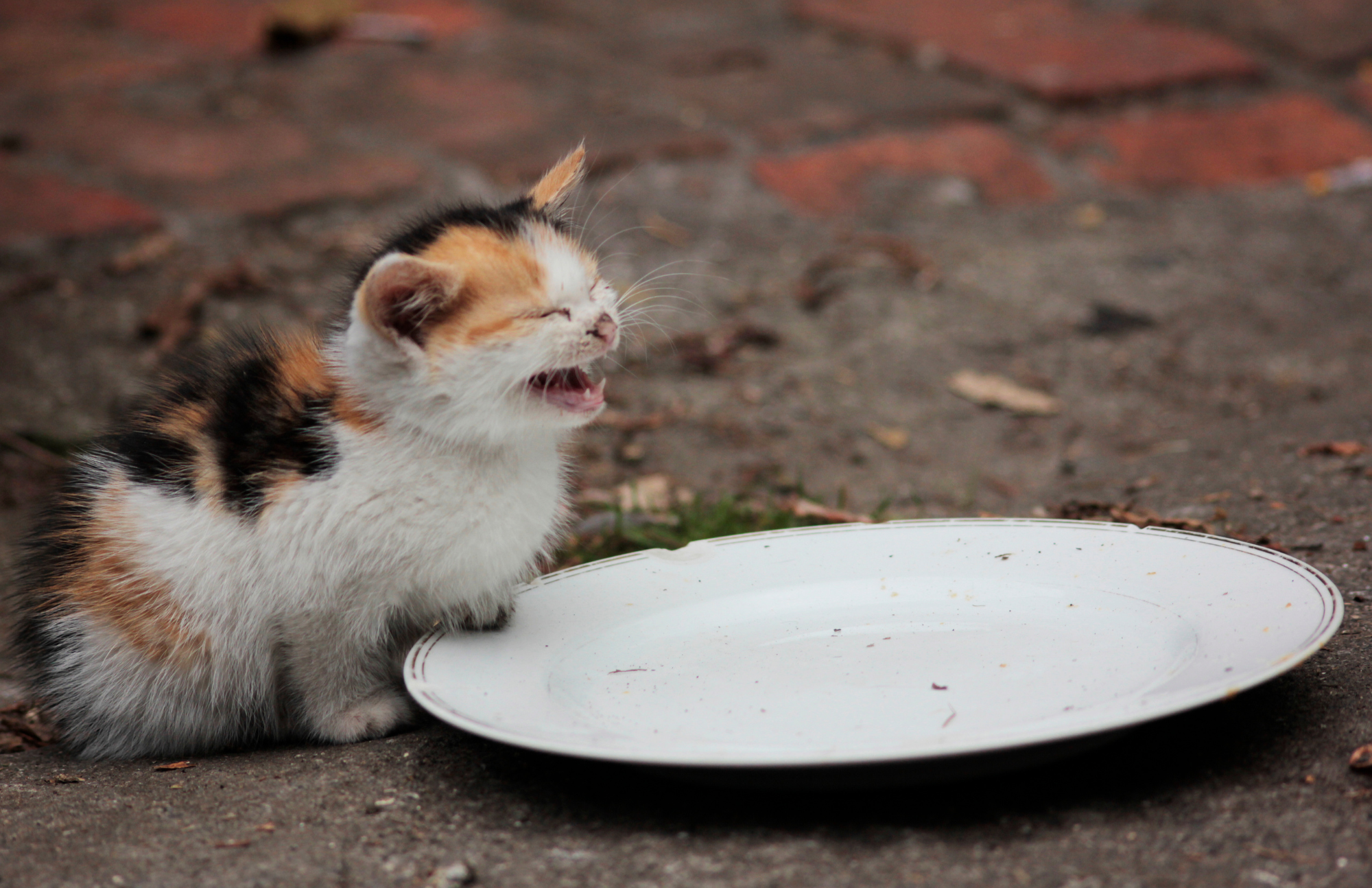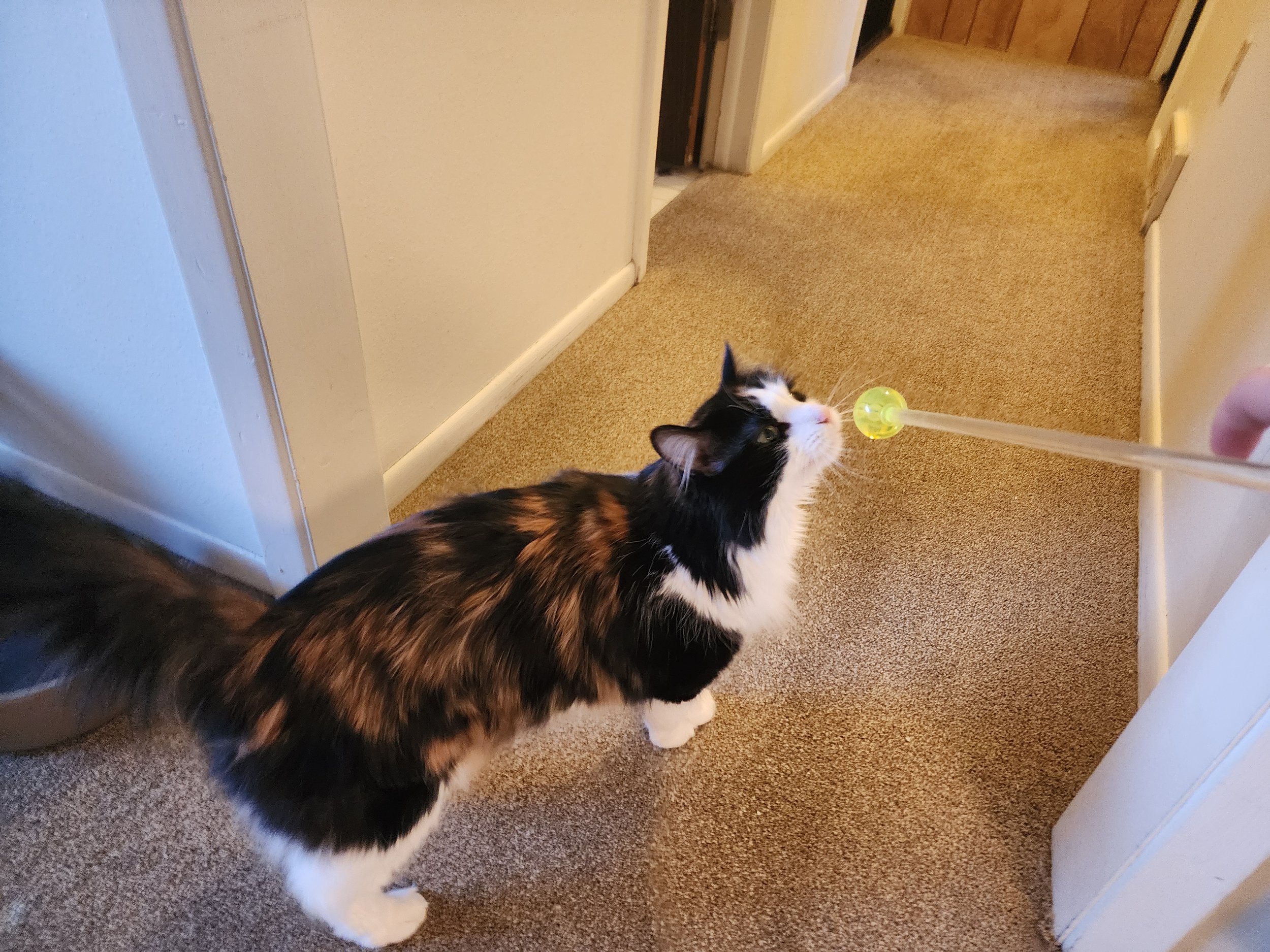Enhancing the Quality of Your Cat’s Life Using Enrichment
There is a buzzword you have likely heard if you work in animal organizations. However, it is starting to spill over into the companion animal world as well. That word is enrichment. What is it? According to the Oxford Languages Dictionary, it is “the action of improving or enhancing the quality or value of something.”
If you have a cat at home, you are probably already using enrichment whether you know it or not. Some people think enrichment is just giving your animal anything other than an empty room. However, enrichment should have a purpose and be evaluated in order to be effective.
What are some of the many goals of enrichment?
1. Promote natural behaviors
What types of behaviors does your cat naturally display? Look at the natural history of a cat. What are the instinctive behaviors you would see them using in the wild? A few behaviors that come to mind quickly are scratching their nails, climbing trees, and grooming themselves. You can provide them enrichment to promote these behaviors.
2. Decrease undesirable behaviors
What behaviors can be problematic in the household? You might get annoyed at your cat for scratching on the furniture (even though this is a natural behavior), chewing on electrical cords, or jumping up on high surfaces, such as your counters. What are enrichment items you can give them to reduce these behaviors?
3. Increase mental and physical stimulation
Animals can feel boredom and anxiety, too. Without an enriched environment, animals can get stir crazy and start performing what we call stereotypic behaviors, or repetitive behaviors with no clear purpose. Think about yourself in a room where you are either anticipating something or you just have nothing to do. What are you doing? Sometimes, people bounce their leg repetitively, some chew or pick at their nails, others might twirl their hair. These behaviors have no purpose other than to displace energy. Animals have stereotypies, too.
Giving them enrichment that physically or mentally challenges them helps to keep them occupied and reduce stereotypic behaviors. It can also help them stay physically healthy if they are more active.
4. Increase choice and control in their environment
In their natural environment, animals make decisions every day. They choose when to hunt, what they eat, where they sleep, and how they play. When they live with humans, that choice is often taken away and they lose control of their environment. This can lead to stress and stereotypic or undesirable behaviors. Giving them options and novel items helps give that choice and control back to the animal and increases their welfare.
5. Strengthen the human-animal bond
You might have a cat who is indifferent to or even fearful of you, or maybe you just want to make your relationship with your cat even stronger. Using certain types of enrichment can help build a bond between the two of you and you’ll notice they become more excited about what they get to do with you next.
What types of enrichment can you give your cat to reach these goals?
1. Feeding Enrichment: Changing up what and how your cat gets fed to increase the length of feeding time and provide novelty.
Puzzle Feeders
A simple puzzle feeder, a more complex puzzle feeder, and a toilet paper tube repurposed as a puzzle feeder
In the wild, animals spend a large chunk of their day foraging or hunting for food. When they live with humans, that food is handed to them in a bowl and they don’t spend as much time performing that foraging/hunting behavior. When we give them puzzle feeders, it not only increases the time that they spend eating, it keeps them mentally and physically stimulated for longer periods throughout the day.
Puzzle feeders can be simple—bowls with obstacles inside them. They can be complex with compartments they need to open using various strategies. If you don’t want to spend the money on all these feeders, you can even use things around your house like toilet paper tubes with the ends folded in. Get creative, but make sure that whatever you use is safe for your cat—either they can’t possibly ingest it, or it’s digestible if they do.
Novel Food Items
Different flavors of Churu can be mixed into their diet or used as a treat on their own!
If you have ever had leftovers you’ve worked on for days, you might realize how boring it is to eat the same thing every single day. Your cat likely eats the same flavor of the same kibble every single day. There is nothing wrong with that as that kibble provides the nutrition they need and extreme changes in diet can actually make them sick. However, it is nice to give them a little special treat every now and then. Try a meal topper or a different flavor of treat.
Presenting Food in a Different Way or at Different Intervals
A kitten demanding that it is food time
Do you always give your cat food at the same time every single day? Do you notice how they start to anticipate feeding time and start meowing incessantly or even performing undesirable behaviors to get your attention? You can try presenting their food on a variable schedule in order to decrease that anticipation.
Just like giving them novel food items, you can present their food differently so that it increases the variety as well. You can try putting water in their food to give it a different texture, or even present it in different bowls or puzzle feeders so they are not eating out of the same thing every single day. I usually have multiple puzzle feeders that I rotate through. It also helps keep up the challenge of the puzzle feeder when it is switched out.
2. Social Enrichment: Providing opportunities for your cat to interact positively with other cats and you!
Play
My cat, Ezi, eyeing her dangly toy
If your cat gets along well with other cats, giving them opportunity to play with each other is an excellent form of enrichment. Play is an extremely satisfying behavior no matter the animal. If they don’t have a cat companion (or even if they do), you should play with your cat, too! The cat wands with the dangly bits at the end are fun for your cat to chase. Some people even have cats that play fetch with them! No matter how you play, you are not only increasing the physical activity of your cat, you are also strengthening your bond.
Grooming
The sandpaper feel of a cat’s tongue comes from the hook-like papillae that help them groom
Cats spend a large amount of time grooming themselves, other cats, and even you. They have that sandpaper tongue that has something called papillae all over the surface. Tongue papillae help grab onto particles to pull them out of their fur and keep them nice and clean. Do your cat the favor of grooming them back! Personally, my cat loves to get brushed right on her forehead and cheeks. They also just love soft pets and scritches. It helps build the human-animal bond between you two.
Training
My cat, Ezi, touching a target stick with her nose
Yes, you can train your cat! They have a lower threshold of tolerance than a dog, so they get frustrated more easily. When training, it’s important to pay attention to how you cat is feeling by watching their body language and response to cues. Increasing the rate of reinforcement, providing high value rewards, and setting obtainable goals for you cat are all excellent ways to keep your cat engaged in a training session. This keeps them mentally and physically stimulated, as well as enjoying a little more time with you.
3. Environmental Enrichment: Enriching their environment to give them choice and control and/or mimic their natural environment.
Scratchers
My cat, Ezi, scratching her nails on an inexpensive scratcher I got at the pet store
Are you annoyed with your cat scratching on the furniture? You do not (and ethically should not) need to get them declawed. Get them a scratcher and redirect them to it whenever they start scratching on furniture. Eventually they will get the hang of scratching on the correct surface. Scratching is natural behavior and you will not get rid of it. Giving them an alternative surface to scratch on is the best way to prevent the undesirable behavior of ruining your furniture.
Cat Trees
Cat trees are many things in one. They provide height, hiding spaces, scratching surfaces, and often times toys as well.
Cats naturally want to stay high. Not only does it help them get a better view of their surroundings, it helps them feel safer. Giving them a tree to climb and sleep on is a great way to keep them feeling comfortable in their environment. Many cat trees come with built-in scratchers and dangly toys as an added benefit. This was one of the first things I bought when I adopted my cat. I would not recommend bringing a cat home without one!
c. Cardboard boxes
A box that serves as both a place to sit, but also as something to chew on
“If I fits I sits” as the saying goes. Cat love to sleep in boxes. They feel protected and hidden inside them. If your cat is anything like mine, they also like to chew on boxes. When I first brought my cat home, she would chew on cords to get my attention. It worked! She had me trained well. When I realized she liked chewing on cardboard boxes, I would put those in front of the cords. She started out chewing on the boxes when she wanted my attention about half the time. I tried to make a point of responding to her positively when she chewed on the less dangerous object and, over time, the more desirable behavior increased and the undesirable behavior was almost completely eliminated.
4. Sensory Enrichment: Providing opportunities for your cat to use their different senses to explore.
Catnip!
The nepatalactone in catnip binds to olfactory receptors in a cat’s nose, sending signals to the brain that cause them to become excited. It’s hypothesized that eating catnip instead mellows cats out, and some cats don’t respond due to genetics.
Do I need to say more? All cats are different. Some may respond to it by becoming more stimulated while others become more mellow. Some cats do not respond to it at all. A compound in the catnip plant called nepetalactone binds to olfactory receptors in your cat’s nose, sending signals to their brain that get them excited. There is some belief that, when your cat eats it instead of smelling it, it makes them more mellow. That cat’s that don’t respond to it at all are hypothesized to lack a gene or have a gene turned off that is associated with the reaction to catnip. If your cat seems to love catnip, give it to them every once in a while.
Smelly things
A cat sniffing flowers. Make sure any plants or scents you give your cat are safe for them—many thing can be toxic to them.
When I work with animals like sheep, elephants, or any herbivore that’s got a strong-smelling odor, I come home and my cat immediately starts scent-rubbing my pants, shoes, or whatever else happened to absorb the smell. She also really loves the smell of men for some reason.
Do some research on safe scents for your cat and try some out to see how they respond!
Catios or opening a window with a screen
Even a closed window still offers visual and sometimes auditory enrichment
Access to the sights, smells, and sounds of the outside stimulates most of your cat’s senses. You might hear them chatter at birds preening themselves, sniff the breeze, or respond with excitement to the sound of squirrels chirping in a nearby tree. Allowing them safe access to the outside world is one of the most optimal forms of enrichment.
5. Physical Enrichment
Walks
Give your the cat the opportunity to explore the outside safely by taking them out on a harness and leash
You can take your cat on a walk, but it usually takes some counter-conditioning to get them in a harness and on a leash. It’s not like walking a dog; your cat is walking you. The outside environment can be scary and overwhelming. Be patient with your cat and listen to them when they are outside. If they want to go back inside, let them. If they don’t want to go a certain direction, don’t tug on the leash. Instead, allow them to explore the places they want to explore and, gently pick them up if they won’t move where you need them to despite coaxing. Be careful, if your cat is scared, they may react to you picking them up. Walks are a safer way to allow your cat to explore the outside safely.
Active play
A cat pouncing on something
Using dangly wands, lasers, playing fetch, or even engaging in chase (but be careful if your cat does not have good bite inhibition) are great ways to keep your cat moving and physically fit.
Toys that encourage movement
Ezi playing with a ball on a track
There are several toys that get your cat to chase. Some cats are great at self-entertaining and will throw their toys up in the air and chase after them all by themselves. Others need a little more help. You can get battery-operated toys that bounce around, or you can get toys with a ball on a track that they can push around and chase. There are even apps that have animated fish or mice running around for your cat to “catch.”
If you want to enhance your cat’s life at home, there are plenty of enrichment opportunities you can provide. This is by no means an exhaustive list, but I hope it gives you some ideas or inspiration to try something new with your cat. Whatever you try, make sure to evaluate how your pet is using it. Does it accomplish the goal, do they love it, are they indifferent to it, are they fearful of it, does it pose any hazards? If it doesn’t accomplish your goals or produces a negative outcome, try something else!















